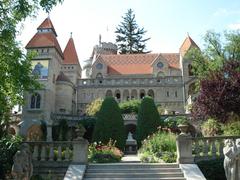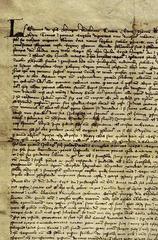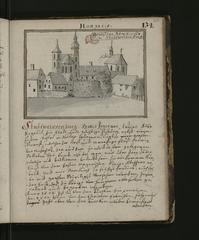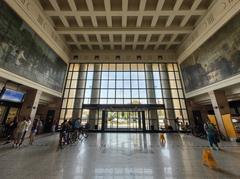Rózsa utca Visiting Guide: Hours, Tickets, and Attractions in Székesfehérvár
Date: 31/07/2024
Introduction
Rózsa utca, nestled in the heart of Székesfehérvár, Hungary, stands as a testament to the rich historical tapestry and cultural significance of this ancient city. Known as ‘Rose Street’ in English, Rózsa utca is not merely a thoroughfare but a vibrant encapsulation of Székesfehérvár’s storied past. With its origins tracing back to the early 19th century, the street embodies a blend of historical eras, architectural styles, and cultural influences. (Fehervarneked)
The significance of Rózsa utca is multifaceted. It is believed to have ties to the legend of Gül Baba, a Turkish dervish credited with introducing rose culture to Hungary, and it was once home to the Veli bej dzsámija, a mosque built during the Ottoman occupation. Over the years, the street has evolved from its military and religious roots to become a cultural hub within Székesfehérvár’s Old Town, known for its Baroque and Classical buildings. The classicist residential building at the junction of Rózsa Street and Fő Street, constructed in the 1820s, stands as a monument of historical significance, reflecting the influence of Habsburg rule. (Wikimedia Commons)
Modern-day Rózsa utca is a well-preserved historical area that attracts both locals and tourists alike. Its vibrant cultural scene is highlighted by events such as the Székesfehérvári Királyi Napok (Royal Days), which celebrates the city’s royal heritage with a series of cultural programs. Visitors can enjoy a leisurely stroll through the street, capturing the intricate architectural details, exploring key landmarks, and indulging in local Hungarian cuisine. (Királyi Napok)
This guide aims to provide a comprehensive overview of Rózsa utca, covering its historical background, architectural significance, and practical visitor information. Whether you are a history enthusiast, an architecture aficionado, or a casual tourist, Rózsa utca offers a unique glimpse into the past and a memorable cultural experience.
Table of Contents
- [Exploring Rózsa utca: History, Architecture, and Visitor Tips in Székesfehérvár](#exploring-rózsa-utca-history-architecture-and-visitor-tips-in-székesfehérvárexploring-rózsa-utca-history-architecture-and-visitor-tips-in-székesfehérvár)
- [Introduction](#introductionintroduction)
- [Early History and Origins](#early-history-and-originsearly-history-and-origins)
- [Architectural Significance](#architectural-significancearchitectural-significance)
- [Ottoman Influence](#ottoman-influenceottoman-influence)
- [Military History](#military-historymilitary-history)
- [Cultural and Social Evolution](#cultural-and-social-evolutioncultural-and-social-evolution)
- [Preservation and Modern-Day Significance](#preservation-and-modern-day-significancepreservation-and-modern-day-significance)
- [Visitor Tips](#visitor-tipsvisitor-tips)
- [FAQ](#faqfaq)
- [Conclusion](#conclusionconclusion)
- [Call to Action](#call-to-actioncall-to-action)
Exploring Rózsa utca: History, Architecture, and Visitor Tips in Székesfehérvár
Introduction
Rózsa utca, located in the heart of Székesfehérvár, Hungary, is a street rich in history and cultural significance. From its early connections to the Ottoman era and its role in the city’s military history, to its preservation as a historical landmark, Rózsa utca offers a unique glimpse into the past. This guide provides an overview of Rózsa utca’s historical background, architectural significance, and visitor tips to enhance your experience.
Early History and Origins
Rózsa utca traces its origins back to the early 19th century. The street’s name, which translates to “Rose Street,” is believed to be linked to the legend of Gül Baba, a Turkish dervish credited with introducing rose culture to Hungary. This connection is emphasized by the presence of the “Rózsás ház” (Rose House), a notable landmark on the street (Fehervarneked).
Architectural Significance
One of the most prominent buildings on Rózsa utca is the classicist residential building at 1 Rózsa Street and 1 Fő Street. Constructed in the 1820s, this building is a fine example of classicist architecture, reflecting the influence of Habsburg rule during that period. It has been designated as a monument of historical significance (Wikimedia Commons).
Ottoman Influence
The historical significance of Rózsa utca is enriched by its connection to the Ottoman era. The site where the Rózsás ház now stands was once home to the Veli bej dzsámija, a mosque built by Veli Bey, the bey of the Fehérvár sanjak. This mosque was a significant religious and cultural center during the Ottoman occupation of Hungary (Fehervarneked).
Military History
Székesfehérvár has a long-standing military history, and Rózsa utca played a role in this aspect as well. In the early 19th century, the city constructed barracks to accommodate imperial and royal units stationed there. This was part of a broader effort to house the significant military presence in the city, considered a strategic location (Feol).
Cultural and Social Evolution
Over the years, Rózsa utca has evolved from a street with military and religious significance to a vibrant cultural hub. Now part of Székesfehérvár’s picturesque Old Town, known for its Baroque and Classical buildings, Rózsa utca offers a glimpse into the city’s rich history and architectural heritage (My Wanderlust).
Preservation and Modern-Day Significance
Today, Rózsa utca is a well-preserved historical area that attracts both locals and tourists. Historical buildings like the classicist residential building and the Rózsás ház are protected as monuments, ensuring their architectural and historical value is maintained (Szarcsa). Visitors can enjoy a leisurely stroll through the street, taking in the historical ambiance and exploring the various landmarks.
Visitor Tips
For those planning to visit Rózsa utca, here are some tips to enhance your experience:
- Visiting Hours and Tickets: While Rózsa utca itself is accessible at all times, specific landmarks like the Rózsás ház may have designated visiting hours and ticket requirements. Check local listings or official websites for the most accurate information.
- Guided Tours: Consider joining a guided walking tour to learn more about Rózsa utca and the surrounding Old Town. These tours often include visits to key landmarks and provide valuable insights (Programturizmus).
- Photography: The classicist architecture and historical buildings make Rózsa utca a perfect spot for photography enthusiasts. Capture the intricate details and unique features of the buildings.
- Local Cuisine: After exploring Rózsa utca, enjoy the local cuisine at nearby restaurants or cafes. Székesfehérvár offers a variety of dining options showcasing traditional Hungarian dishes.
- Festivals and Events: Check the local event calendar for festivals or cultural events during your visit. Notable events include the Székesfehérvári Királyi Napok, celebrating the city’s royal heritage (Királyi Napok).
FAQ
- What are the visiting hours for Rózsa utca? Rózsa utca is accessible at all times, but specific landmarks like the Rózsás ház may have designated visiting hours.
- Are there guided tours available? Yes, guided tours are available and provide valuable insights into the history and significance of Rózsa utca and the Old Town.
- Is there an entry fee for Rózsa utca? Rózsa utca itself is free to visit, though some landmarks may require tickets.
Conclusion
Rózsa utca in Székesfehérvár is a street rich in history and cultural significance. From its early connections to the Ottoman era and its role in the city’s military history to its preservation as a historical landmark, Rózsa utca offers a unique glimpse into the past. Visitors can enjoy its architectural beauty, learn about its historical importance, and experience the vibrant culture of Székesfehérvár.
Call to Action
Plan your visit to Rózsa utca today to explore its historical charm. For more information, download the Audiala mobile app, check out related posts on our website, or follow us on social media for updates and travel tips.
References
- Fehervarneked. (n.d.). Rózsás ház. https://www.fehervarneked.hu/hu/reszletek/rozsas-haz
- Wikimedia Commons. (n.d.). Listed residential building ID 3823. Classicist, 1820s. - 1, Rózsa St., 1, Fő St., Downtown, Székesfehérvár, Fejér County, Hungary. https://commons.wikimedia.org/wiki/File:Listed_residential_building_ID_3823._Classicist,1820s.-_1,_Rózsa_St.,_1,_Fő_St.,_Downtown,_Székesfehérvár,_Fejér_county,_Hungary.JPG
- Programturizmus. (n.d.). Székesfehérvári idegenvezetés. https://www.programturizmus.hu/ajanlat-szekesfehervari-idegenvezetes.html
- Királyi Napok. (n.d.). Székesfehérvári Királyi Napok 2024. https://kiralyinapok.szekesfehervar.hu/szekesfehervari-kiralyi-napok-2024





